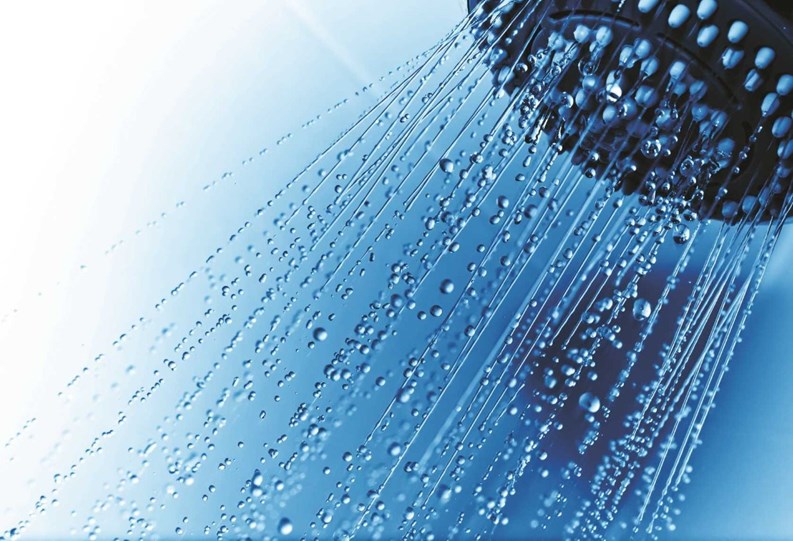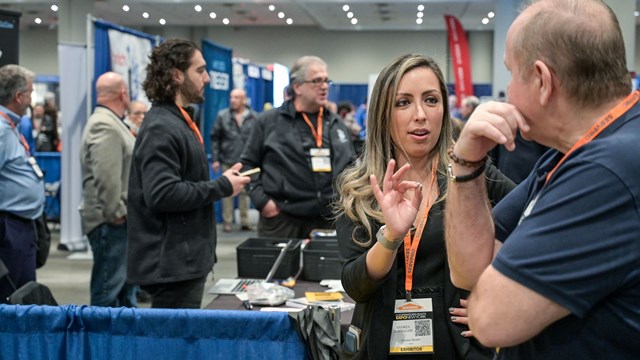The 14th Street Townhomes, a 36-unit Pompano Beach condominium built in 1991, doesn’t have a vast expanse of grass. It occupies less than five acres of land, yet in 2008 it began saving 5,000 to 10,000 gallons of drinking water a year by irrigating its modest lawn with reclaimed water.
“We were the first condominium in Florida to receive grant funds for such a project,” says association president Nick A. Damasceno. The project cost $9,194, of which the grant from the South Florida Water Management District covered $3,677.95. The association paid the difference.
“After the pipeline was completed, other properties along the 14th Street Causeway between Federal Highway and the Intracoastal Waterway (a distance of about six-tenths of a mile) also hooked up to the pipeline and began using reclaimed water,” Damasceno says.
In 2009, the association received another grant from the SFWMD for plumbing retrofits, installing low-volume toilets that use only nine-tenths of a gallon per flush, low-flow aerators on the sink faucets, and low-flow shower heads.
The total cost was $30,573.55, of which the grant paid $15,286. The association covered the remainder, including $4,400 in voluntary contributions of $50 per toilet from the owners. “It wasn’t a special assessment because it wasn’t mandatory, but everyone contributed,” Damasceno explains.
Together, Damasceno says, the reclaimed water and plumbing retrofit projects save 2,267,027 gallons of drinking water a year, reducing the condominium’s use of drinking water by 62 percent.
Seeking Incentives
The 14th Street Townhomes experience illustrates how condominiums and homeowners associations can “green” their communities by embracing eco-friendly initiatives, and how incentives can make the upfront expense more affordable.
Before all else, a community must commit to making itself eco-friendly. “The first course of action for a condo or HOA would be to survey the residents,” suggests Denise Bevan, senior environmental planner for Palm Coast, a city of 75,000, south of St. Augustine in Flagler County. Bevan recommends asking HOA residents to suggest initiatives for the community, including use of reclaimed water, a solar-energy installation, appliance upgrades, enhanced recycling arrangements, and stations for proper disposal of pet waste (where pets are allowed). Then conduct a survey. The board of directors can use the results to gauge support for and prioritize the various possibilities.
Once eco-friendliness becomes association policy, the board must find money to pay for whatever enhancements it chooses to embrace. Incentives from public and private sources can help to establish feasibility and focus decision-making. So can payback calculations. All other things being equal, a project that will pay for itself in a year or two will be more attractive than one with a 15-to-20-year payback.
Public-Sector Sources
Until 2008, the Florida Office of Energy (FOE) typically received about $1 million a year in federal funds from the U.S. Department of Energy for energy-efficiency grants. Then the American Recovery and Reinvestment Act of 2009 (commonly referred to as President Obama’s stimulus plan) brought the FOE a four-year, $175-million gush of funding. Counties and municipalities received much of this money for distribution to their local residents through rebate programs for Energy Star appliances that use less electricity, and loans for installation of home solar-power systems.
“All of these dollars should have been expended by April 30, 2012,” says Patrick Sheehan, FOE executive director. “We don’t expect to receive anything like that type of money again.”
Sheehan says the FOE now plans a statewide clearinghouse of information on energy programs available from all sources that will “analyze for Florida consumers what they provide and how effective they are.” Visit the website at www.floridaenergy.ufl.edu. “We will be marrying their data with federal and state data,” Sheehan says. “Condo and homeowners associations will be able to look at this database and get information geared to them as consumers to determine various energy-efficiency and conservation steps they can take, and public or private incentives that may be available to them
“Our goal is to expand it even further and categorize it so if you’re a condo dweller in an apartment building or an HOA with single-family homes, you can go to a specific tab.”
Other Public-Sector Sources
Two other databases already exist to help locate funding sources:
• The Database of State Incentives for Renewables & Efficiency, www.dsireusa. org, is a project of the N.C. Solar Center and the Interstate Renewable Energy Council with funding from the U.S. Department of Energy. It is organized by state and within each state by program type.
• The U.S. Department of Energy’s own website has a section on tax credits, rebates, and savings at http://energy.gov /savings. Filters allow you to sort this database to focus on multi-family residential projects in Florida. These databases don’t necessarily include all local-government initiatives, so ask your municipality and county whether they have an incentive program for what you want to do.
For example, Palm Coast will waive building permit fees for projects that can demonstrate pursuit of “a recognized green standard” such as certification by the Florida Green Building Coalition (FGBC) or the U.S. Green Building Council’s Leadership in Energy and Environmental Design (LEED) program. “We don’t want people to install something without a measurable accountability. You have to show that you’re seeking a standard, and we will hold you to compliance,” Bevan says.
Choose a Green Standard
Choosing which set of recognized green standards to comply with can be complicated. Depending on the nature of your project, one set of certification requirements may cost more to meet than another.
LEED has nationwide visibility and prestige—and a high degree of complexity. In addition, says Suzanne Cook, FGBC executive director, LEED standards are “national, and developed for cooler climates. The FGBC standards were specifically created with climate-specific criteria for Florida’s hot, humid environment. National programs focused predominantly on heating may have a higher number of fresh-air exchanges in the air conditioning, so in a hot, humid climate you would bring in moisture and start forming mold.”
Cook says most green certification programs are targeted at new construction. “For an existing building,” she says, “certain things are essential. You have to bring the building up to at least the current code requirements for energy efficiency, such as low-flow toilets, vanity faucets, and shower heads, and the pool motor. Also important is a roof-to-wall connection upgrade for disaster mitigation.”
Private-Sector Sources
Many utility companies offer energy-efficiency incentive programs for their customers. In South Florida, Florida Power & Light Company has programs for individual homeowners, and also business-oriented programs for which a condominium or HOA may qualify, advises spokesman David McDermitt. FPL’s business incentive programs include:
• Climate control: installing more energy-efficient air-conditioning equipment, and cleaning or replacing air-conditioning ducts.
• Water heating: installing energy-reducing technologies such as a heat-recovery unit and a heat-pump water heater.
• Lighting: replacing inefficient lighting systems with more energy-efficient ones to reduce energy use and improve lighting quality.
• Building envelope: installing energy-saving measures to improve a building’s thermal “shell,” such as roof and ceiling insulation, reflective roof coatings and membranes, and window treatments (solar film, solar screens, and high-efficiency replacement windows).
• Solar photovoltaic (PV) and solar water-heating systems.
For more information about these programs, visit www.fpl.com/bizprograms.
“For any condo or HOA, the starting point would be to visit www.fpl.com/bee and schedule a free business energy evaluation,” McDermitt says. “A specialist will come out to review the interior and exterior common areas, including central air conditioning, indoor and outdoor lighting, and pool pump motors. He will assess where your energy dollars are going and come back with recommendations on how to reduce those bills.”
FPL also can offer community associations guidance on vegetation management. “Tree limbs and palm fronds growing near power lines are one of the most common causes of power outages,” McDermitt says. “We recommend that community associations trim their vegetation annually, and plant the right tree in the right place. When you plant new trees and large bushes, don’t plant something that will grow big right under an overhead power line.” For recommendations on what to plant where, visit www.fpl.com/trees.
Help from Lawmakers
In recent years, the Florida Legislature has passed new laws that supercede condominium or homeowners association documents requiring turf grass and prohibiting rooftop solar panels.
The landscaping bill (Senate Bill 2080), which became law in 2010, encourages “Florida-friendly landscaping” with plants adapted to a specific site that require little or no watering, fertilizing, and pesticide application.
“This gave homeowners in an HOA more leeway in what they could use. It’s a good thing. Turf grass requires a lot of maintenance and water,” says Suzanne Cook, executive director of the Florida Green Building Coalition.
Section 163.04 of the Florida Statutes gives homeowners the right to install rooftop solar panels. An HOA may limit where on the roof the panels are placed, although not to the extent of impairing their efficiency, says Colleen Kettles, former legal counsel for the Florida Solar Energy Center and current executive director of the Florida Solar Energy Research and Education Foundation. After a court decided that Section 163.04 did not apply to HOAs, the legislature amended the law “to specifically include actions taken by homeowner associations,” Kettles says.
“It is important to seek the approval of a homeowners association prior to the installation of a solar system,” she says. “The law protecting the installation of solar does not waive the need for association approval if it is required by the governing documents.” To learn more about Florida’s rooftop solar panel law, visit www.fsec.ucf.edu/en/consumer/solar_hot_water/q_and_a/rights.htm#s163.
Consultants & ESCOs
Unless someone on your board or management staff has the expertise to research and evaluate energy-efficiency measures, your community association may be wise to seek specialized assistance. Look for a consulting engineer with a background in energy conservation. Then request and check references from previous clients—ideally including other community associations with needs similar to yours.
Another source of guidance is an energy services company (ESCO). “It can show you what to do, such as retrofits on lighting, solar water heaters, and double-pane windows,” Sheehan says. Such an arrangement is often called energy performance contracting. For more information about ESCOs, visit www.energyservicescoalition.org. For information specific to Florida, visit www.energyservicescoalition.org/chapters/ FL/resources.htm or download materials at www.energyservicescoalition.org/chapters/FL/manual/Florida%20Manual.pdf.
George Leposky is a freelance writer and editor living in Miami, Florida.





Leave a Comment